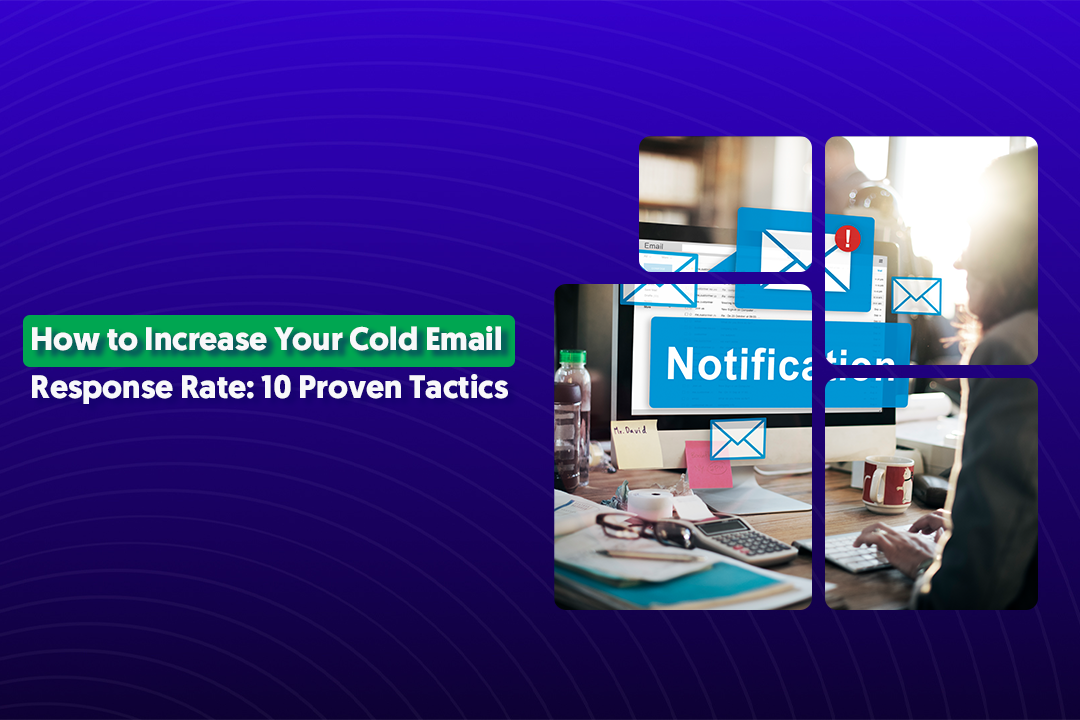Table of Content
Key Takeaways
- The best time to send cold emails is Tuesday - Thursday between 9-11 AM in your prospect's local time zone.
- Start with 20-50 emails per day for new domains and gradually increase to 100-200 for warmed domains..
- Always adjust send times based on recipient time zones. Sending during their work hours can boost reply rates by 10-15%.
- 60% of replies come after the 2nd or 3rd email, so build multi-touch sequences with follow-ups spaced 2-3 days apart.
- Quality beats quantity every time. 100 personalized, well-targeted emails will generate more meetings than 1,000 generic blasts.
- Test your timing with A/B tests and let your own data guide decisions.
You've crafted the perfect cold email. The subject line? Brilliant. The copy? Tight and personalized. The CTA? Crystal clear.
But here's the thing - if you send it at the wrong time, it's going to get buried under 50 other emails before your prospect even opens their inbox.
Timing isn't just a small detail. It's the difference between a 20% open rate and a 45% one. Between crickets and booked meetings.
So when is the best time to send cold emails? We've analyzed millions of emails sent through our cold email lead gen services at Cleverly, and the data tells a clear story.
In this guide, we're sharing exactly what works—backed by real data from campaigns that have generated over $312 million in pipeline revenue for clients like Amazon, Google, and Uber.
No guesswork. Just proven cold email timing strategies you can apply to your outreach today.

Why Timing Matters in Cold Email Outreach
Look, you can write the most compelling cold email in the world, but if it lands in someone's inbox at 11 PM on a Friday, it's not getting read. Period.
The best time to send a cold email isn't just about picking a random hour and hoping for the best. It's about understanding when your prospects are actually checking their email, when they're most likely to engage, and how to position your message so it doesn't get lost in the noise.
Here's why timing can make or break your cold email campaign.
Inbox Competition Is Real
Your prospects aren't sitting around waiting for your email. The average professional receives over 120 emails per day.
If your email hits their inbox at the wrong moment, it gets pushed down immediately.
By the time they come up for air? Your email is buried on page two, never to be seen again. Timing determines whether you're at the top of the inbox or lost in the scroll.
Time of Day Influences Attention
Not all hours are created equal when it comes to attention spans.
- Early morning (6-8 AM): People are fresh, checking email with their coffee, planning their day. Open rates are high.
- Mid-morning (9-11 AM): The workday ramps up. Inbox checks happen between tasks. This is prime territory for cold emails.
- Lunch (12-1 PM): Some people check email while eating. Others completely disconnect. It's hit or miss.
- Afternoon (2-5 PM): Energy dips. People are less likely to engage with something new unless it's highly relevant.
- Evening (6+ PM): Open rates can be decent, but response rates drop. People are winding down, not ready to start new conversations.
We've seen open rates swing by 15-20% just by shifting send times by a few hours. That's significant when you're running campaigns at scale.
Different Time Zones Require Adjustments
If you're reaching out to prospects across the US—or internationally—you can't just blast emails at 9 AM your time and call it a day.
Sending an email at 9 AM EST means it's hitting inboxes at 6 AM PST. That's way too early for most West Coast professionals. By the time they start their day, your email is already buried.
If your prospect is in London, don't send at 2 PM your time when it's 7 PM theirs. Be smart about when people are actually working.
At Cleverly, we handle this automatically for our clients—personalizing send times based on geography so every email lands when it's most likely to get attention. It's one of those small adjustments that adds up to massive gains over thousands of emails.
The Best Time and Day to Send Cold Emails (Based on Research)
Alright, let's get into the actual numbers. When should you hit send?
We've analyzed millions of cold outreach campaigns at Cleverly, and the patterns are consistent. Some days and times just work better. Here's what the data shows.
Best Days to Send Cold Emails
🤝 Tuesday, Wednesday, and Thursday are your sweet spot.
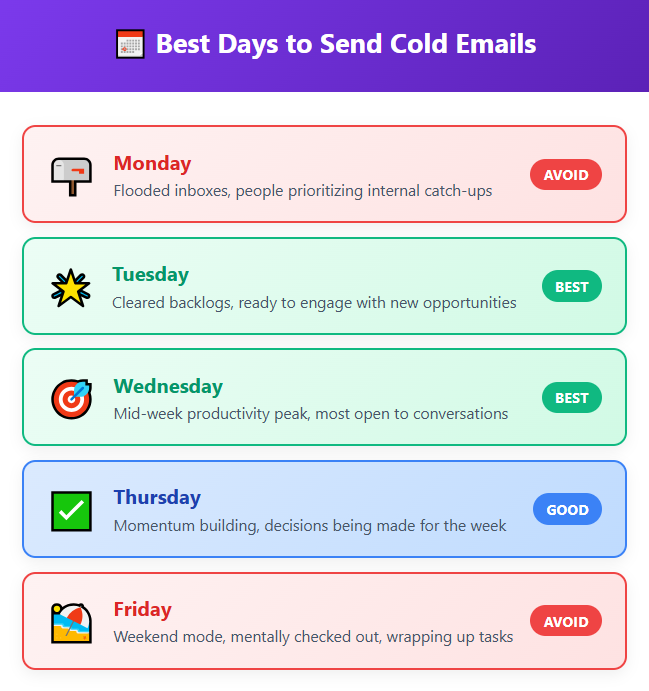
These mid-week days consistently deliver the highest open and response rates. Why?
People are settled into their work rhythm. Monday chaos is behind them, and they're not mentally checked out for the weekend yet.
Here's the breakdown:
- Tuesday: Often cited as the single best day for cold email. People have cleared Monday's backlog and are ready to engage with new opportunities.
- Wednesday: Equally strong. You're catching prospects mid-week when they're most productive and open to conversations.
- Thursday: Still solid. Decisions are being made, meetings are happening, and there's momentum toward wrapping up the week.
- Monday: Avoid it if you can. Inboxes are flooded from the weekend, people are prioritizing internal catch-ups, and your cold email is competing with dozens of urgent messages. Open rates drop by 10-15% on Mondays compared to Tuesday.
- Friday: Lower engagement across the board. People are wrapping up, planning their weekend, or already mentally checked out. Response rates can drop by 20% or more.
- Weekends: Unless you're targeting specific industries (like hospitality or retail), don't bother. Your email will sit unread until Monday, and by then it's buried.
Bottom line? Stick to Tuesday through Thursday for the best time to send cold emails and you'll immediately see better results.
Best Time of Day to Send Cold Emails
Now let's talk hours. When during the day should you send?

Morning (9–11 AM) — The Golden Window
This is when most professionals do their first inbox check of the day. Your email has a much better chance of being seen and opened.
We've consistently seen 30-40% higher open rates during this window compared to afternoons.
If you're only going to test one send time, make it between 9 and 10 AM in your prospect's local time zone.
Early Afternoon (1–3 PM) — The Post-Lunch Check
After lunch, people often do another inbox sweep before diving into afternoon tasks. This is your second-best window. Open rates are still strong, though slightly lower than morning.
If you're sending follow-ups or targeting prospects in different time zones, early afternoon is a great backup option.
Late Afternoon (4–6 PM) — Proceed with Caution
Some people check email before wrapping up their day, but response rates drop significantly.
They're tired, focused on finishing tasks, and less likely to engage with something new. You might get opens, but replies? Not as likely.
Evenings and Weekends — Generally Avoid
Unless you're targeting specific roles (like founders or executives who work odd hours) or international prospects, evenings and weekends are a gamble. Most B2B professionals don't want to deal with cold outreach outside of work hours.
That said, if you know your audience works non-traditional hours, test it. But for most campaigns, stick to business hours.
Industry-Specific Timing Insights
Here's where it gets interesting. The best time to send cold emails can vary based on who you're targeting.

B2B Sales & Marketing Professionals: Early mornings (8–10 AM) and early week (Tuesday/Wednesday) work best. These folks live in their inbox and respond quickly to relevant outreach.
Tech & Startups: Mid-afternoon (1–3 PM) often performs well. Startup teams keep flexible hours, and decision-makers are often catching up on email between meetings.
Executives & C-Suite: Very early morning (6–8 AM) can be surprisingly effective. Many executives check email before the office chaos starts. If you can catch them during this quiet window, your message stands out.
Creatives & Freelancers: Late afternoon (3–5 PM) tends to work better. These professionals often work on their own schedules and might not check email first thing in the morning like corporate types do.
At Cleverly, we segment campaigns by industry and role, adjusting send times to match when each audience is most likely to engage.
It's one of the reasons our clients see consistently higher response rates with cold emails. We're not using a one-size-fits-all approach. We're sending at the right time for the right person.
Also Check: Best Time to Cold Call in 2025 (Backed by Data & Research)
How Many Cold Emails to Send Per Day (and Why It Matters)
So you've nailed the timing. Now the question is: how many emails should you actually send?
This is where a lot of people mess up. They think more is always better, so they blast 500 emails from a brand new domain on day one. Then they wonder why their emails are landing in spam or their domain gets blacklisted.
How many cold emails to send per day isn't just about what you can physically send. It's about what you can send without tanking your deliverability and reputation.
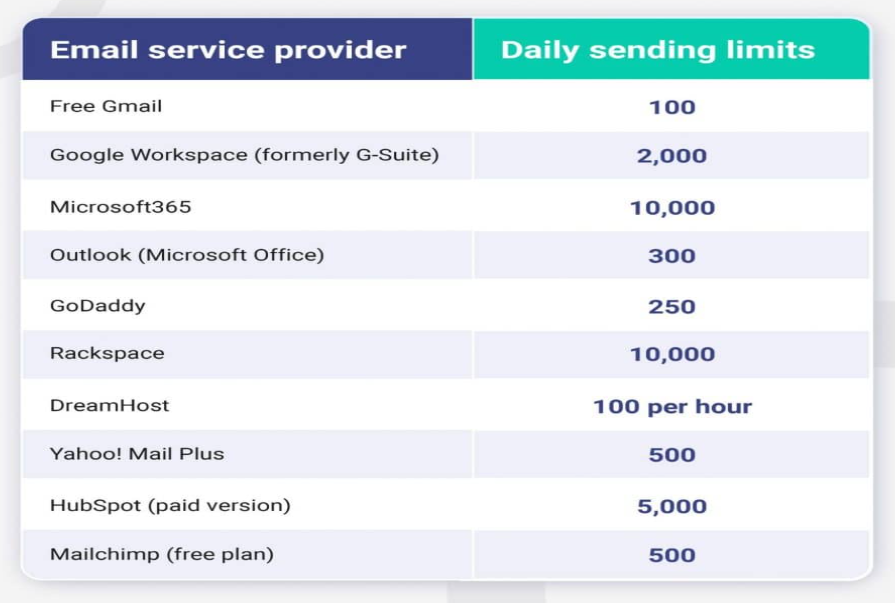
Sending Volume Affects Deliverability
Here's the thing: email providers like Gmail and Outlook are watching how you send.
If you suddenly start sending hundreds of emails from a domain that's barely been used, that's a red flag. It looks like spam behavior. Email providers will start filtering your messages to spam folders or blocking them entirely.
This is why warming up your domain is critical. You need to gradually increase your sending volume over time so email providers see you as a legitimate sender, not a spammer.
Start small. Build trust with email providers. Then scale up. Rushing this process is one of the fastest ways to kill a cold email campaign before it even gets started.
Read More: Best Email Service for Cold Emails - What 10,000+ B2B Agencies Chose
Ideal Daily Sending Limits
So what are the actual numbers? Here's what works based on your domain's age and reputation:
New Domains (0-2 Weeks Old): 20–50 Emails Per Day
If you just registered a new domain or it's barely been used, you need to warm it up slowly.
Start with 20-30 emails per day for the first week, then gradually increase by 10-20 emails each week.
Warm Domains (1-3 Months Old): 100–200 Emails Per Day
Once your domain has a solid sending history and good engagement rates, you can safely send 100-200 emails per day from a single inbox without major deliverability issues.
This is the sweet spot for most businesses running cold email campaigns.
Advanced Setups (Multiple Inboxes): 500+ Emails Per Day
If you need to send at scale, like 500+ emails per day you'll need multiple inboxes and domain rotation. This means setting up several sending domains and distributing your volume across them.
But here's the key: You can't just spin up five domains and start blasting. Each domain still needs to be warmed properly, and you need infrastructure to manage rotation and track performance across inboxes.
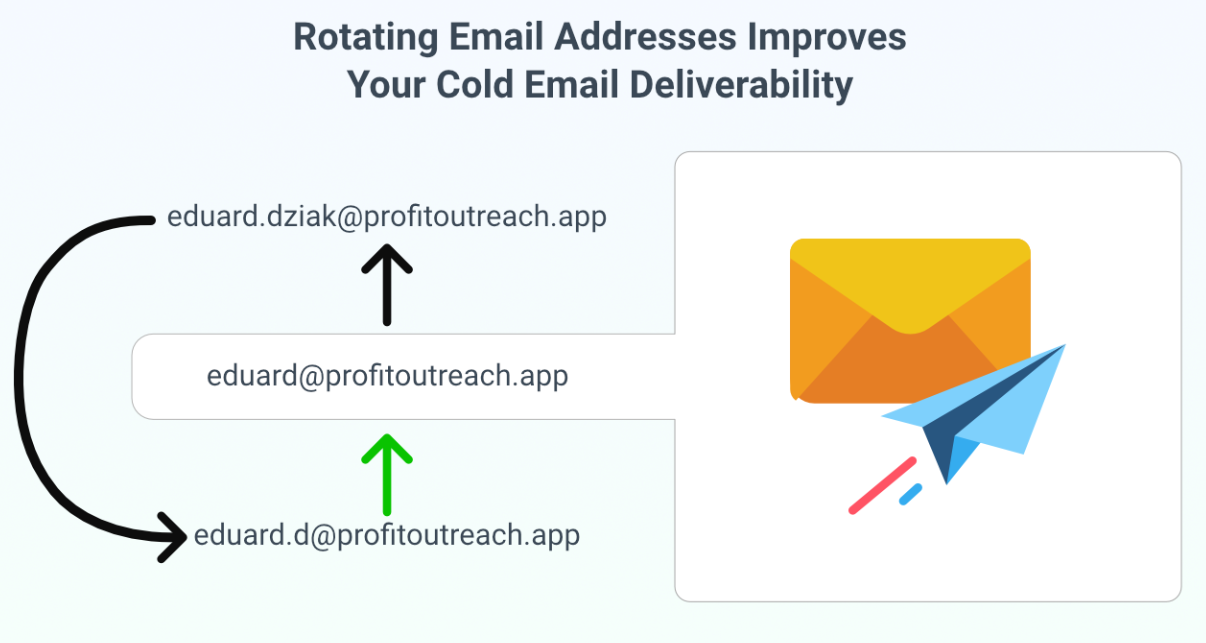
Consistency Over Volume
Here's what most people miss: how many cold emails to send per day matters less than how well-targeted and personalized those emails are.
Sending 1,000 generic, spray-and-pray emails will get you nowhere. You'll burn through your list, annoy prospects, and tank your sender reputation.
But sending 100 highly targeted, well-researched emails to the right people? That can generate 10-20 qualified meetings. That's what actually moves the needle.
So before you worry about sending hundreds of emails per day, ask yourself: are you sending to the right people with the right message? If not, volume won't save you.
The best cold email campaigns balance three things: smart targeting, strong personalization, and sustainable sending volume. Nail those, and you won't need to send thousands of emails to see results.
Cold Email Timing Strategy: Finding Your Perfect Window
Here's the truth: there's no universal "perfect time" that works for every audience, every industry, every campaign.
The best time to send a cold email for your business depends on who you're targeting, where they're located, and what your data tells you.

Test and Track Your Timing
You can read all the studies you want, but nothing beats your own data.
Start by A/B testing different send times with your actual audience. Split your list and send the same email at different times—say, 9 AM vs. 2 PM, or Tuesday vs. Thursday. Then measure what happens.
Track these metrics:
- Open rates: Which send time gets more people to open your email?
- Reply rates: More importantly, which time drives actual responses and conversations?
- Meeting bookings: Ultimately, which timing leads to the most booked calls or demos?
Run these tests over a few weeks to account for any weird one-off days. Once you have enough data, the patterns will become clear.
At Cleverly, we're constantly testing timing for our clients across different industries. What works for SaaS companies often differs from what works for agencies or consultants. Testing is the only way to know for sure.
Here’s an example of cold email outreach done for financial services:
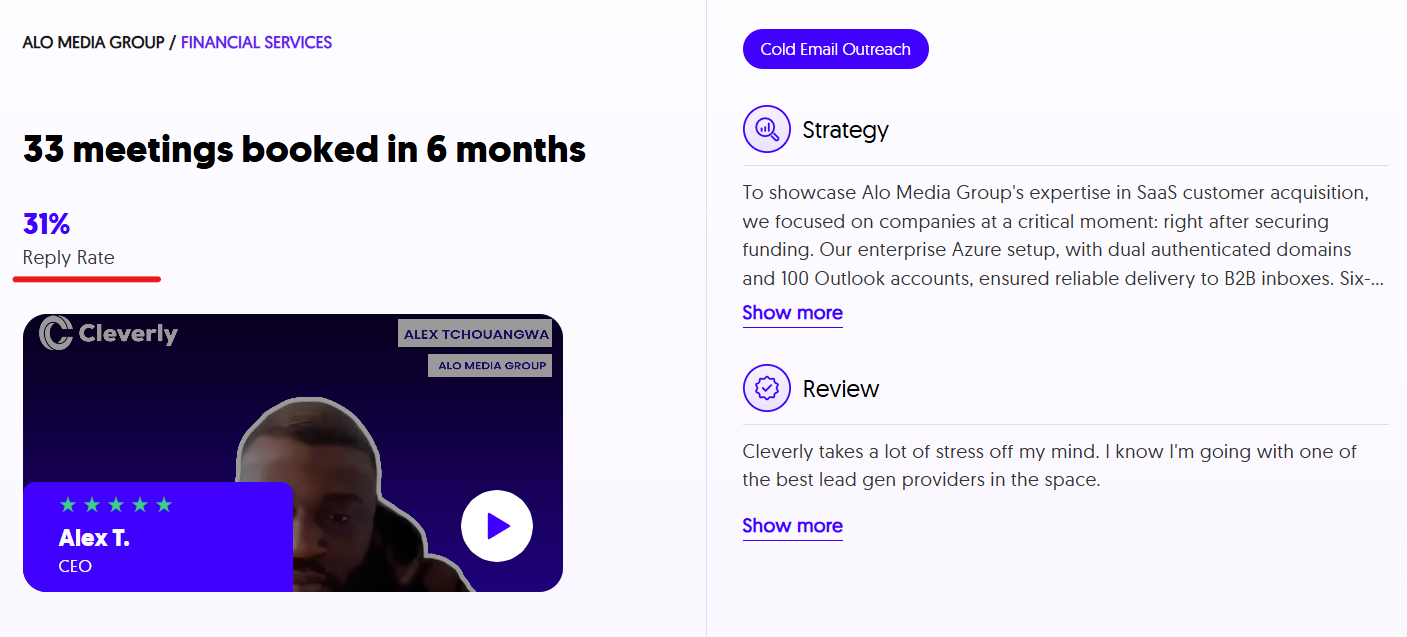
Use Smart Sending Tools
Manual sending doesn't scale, and it definitely doesn't let you optimize timing across hundreds or thousands of emails.
That's where cold email software comes in. Platforms like Instantly, Lemlist, and Smartlead let you automate sending while still controlling exactly when emails go out.
Here's what these tools can do for timing:
- Randomize send times: Instead of blasting 100 emails at exactly 9:00 AM (which looks robotic), these tools can spread sends across 9:00-10:00 AM to look more natural.
- Schedule by time zone: Automatically adjust send times based on where your prospect is located, so everyone gets your email during their work hours.
- Stagger sequences: Set up follow-ups to go out at different times than your initial email, increasing the chances of catching your prospect when they're checking inbox.
These tools handle the logistics so you can focus on what matters—writing better emails and targeting the right people.
To Help You More: How to Choose the Best Cold Email Outreach Software for Your Sales Team
Adjust for Recipient Time Zone Automatically
This one's non-negotiable if you're reaching out across multiple time zones.
Sending an email at 10 AM your time might mean it hits someone's inbox at 7 AM or 1 PM depending on where they are. That timing difference can tank your open rates.
Always send within working hours in the recipient's region. If you're using a cold email tool, this should be automatic. If you're sending manually, segment your lists by time zone and schedule accordingly.
Combine Timing with Follow-Up Sequences
Here's where timing strategy really pays off: your follow-ups.
Most people who don't respond to your first email aren't ignoring you—they just missed it or didn't have time to engage. That's why follow-ups are critical, and timing them right is just as important as timing your initial email.
Plan your cold email follow-up sequence like this:
- Email 1 (Initial outreach): Send on Tuesday or Wednesday morning, 9-10 AM.
- Email 2 (Follow-up): Wait 2-3 days. Send on Thursday or Friday, but at a different time—maybe early afternoon (1-2 PM). This catches them during a different part of their day.
- Email 3 (Final nudge): Wait another 3-4 days. Send early next week (Tuesday), back to morning hours (9-10 AM).
Don't send all your follow-ups at the exact same time as your first email. Mix it up. Some people check email in the morning, others in the afternoon. You want to cover different windows to maximize visibility.
At Cleverly, we've refined multi-touch sequences that combine smart timing with strong messaging. It’s all about sending them at the moments when prospects are most likely to engage.
That's how we've helped clients generate over $312 million in pipeline revenue. Timing, messaging, and persistence all working together.
What the Data Says: Cold Email Timing Benchmarks (Quick Recap)
How Cleverly Optimizes Cold Email Timing for Higher Conversions
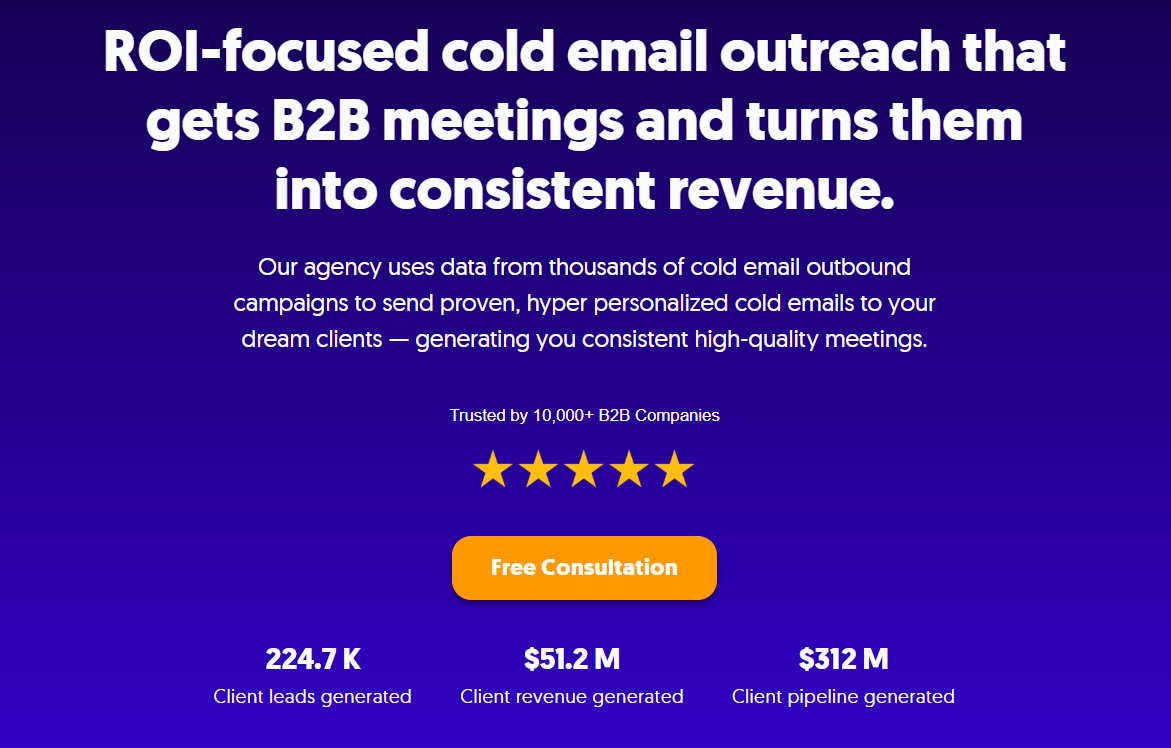
Look, you can read all the guides and studies you want about the best time to send cold emails. But implementing it at scale, across multiple campaigns, time zones, and audience segments—is a whole different challenge.
That's where working with a cold email outreach agency makes the difference.
✅ We don’t guess. We test.
Cleverly’s data-driven outreach team analyzes millions of sends to find your audience’s real sweet spots—what works for SaaS isn’t what works for consultants.
✅ Smart Scheduling, Smarter Sends.
Our system auto-segments by time zone, role, and industry—so every prospect gets your email exactly when they’re most likely to engage.
✅ Timing + Personalization = Results.
We combine perfect timing with personalization, deliverability, and multi-touch sequences that convert.
💸 You only pay for booked meetings.
No fluff. Just qualified leads and real conversations. That’s how we’ve helped 10,000+ clients generate $312M in pipeline revenue with brands like Google, Amazon, and Slack.
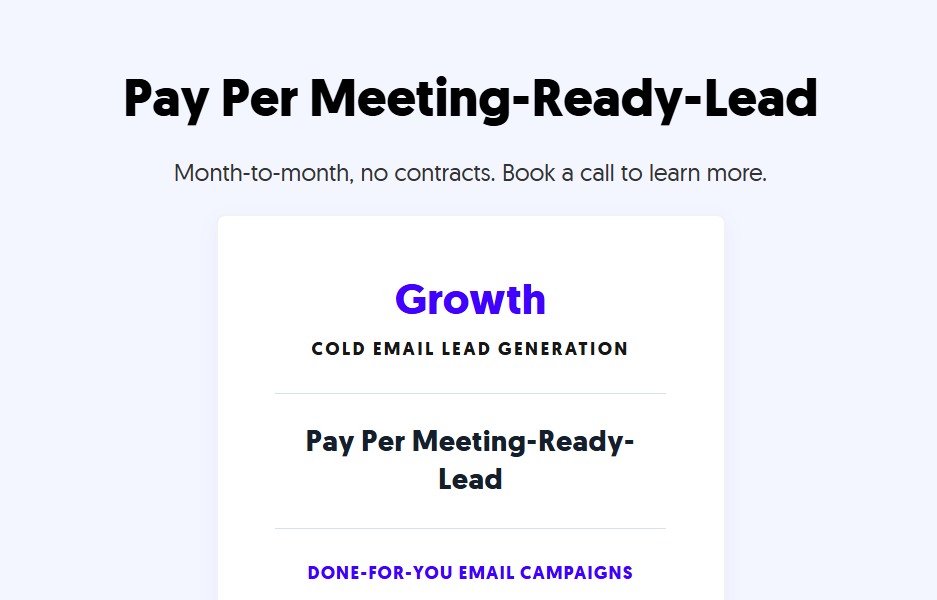
🔥 Stop guessing. Start booking.
Let Cleverly’s experts get your message in front of decision-makers at the perfect moment.

Conclusion
The best time to send cold emails isn't a mystery—it's backed by data, testing, and real-world results.
Send Tuesday through Thursday. Aim for 9-11 AM in your prospect's time zone. Keep your volume sustainable. Test what works for your specific audience. And never underestimate the power of a well-timed follow-up.
But here's the reality: timing is just one lever. The emails that actually generate pipeline combine smart timing with strong messaging, proper targeting, and consistent follow-through.
If you're ready to stop guessing and start booking meetings with decision-makers, Cleverly's team can help. We've cracked the code on cold email outreach—and we only charge when you get results.
Ready to fill your calendar with qualified leads? Let's talk.
Frequently Asked Questions



